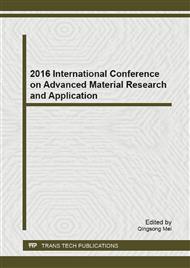p.306
p.317
p.323
p.329
p.334
p.340
p.344
p.349
p.357
Research on Performance of CRTS I Cement-Emulsified Asphalt Mortar on Site
Abstract:
For construction method of infusion bag, expansion of CRTSⅠCA mortar on site by core drilling, water absorption, chloride ion permeability and frost resistance and other properties were studied in comparison with performance of mortar in laboratory under standard curing. The results showed that expansion of the mortar on site was 2%, water absorption was 0.5%, charge amount was 210C, quality loss after 300 freeze-thaw cycles was -1.1%, the performance was much better than molded mortar in laboratory. Pore structure analysis showed that the internal pore diameter of the mortar on site was about 150μm, pore content was 9% to 12%; the internal pore diameter of the mortar in laboratory was also about 150μm, pore content was 10% to 15%. China railway track system(CRTSⅠ)slab ballastless track is one of the main structure forms of the modern high-speed railway and mainly composed of concrete basement, the Cement-emulsified Asphalt Mortar layer and concrete slab, featured by its rapid construction, convenient maintenance, and so on, has been widely applied in high-speed railway construction in our country. The cement-emulsified asphalt(CA) Mortar is one of the key materials and structures in slab ballastless track, providing the appropriate stiffness and elasticity which is usually composed of cement, emulsified asphalt, grit, water and many types of additives, containing a variety of inorganic/organic compositions and many types of surfactants, through the special bag, filling inside the flat cavity by its own weight between track slab and concrete basement with a thickness of 50mm (length×width 4962 mm×2400 mm). The construction method of CA mortar is grouting the non-woven fabrics bag after setting the bag under the track slab fixed by fine adjustment claw, which is convenient and has no requirement of mould removal. The bag is fixed before the perfusion process and does not produce wrinkles. The method greatly enhances the construction efficiency and has been widely utilized in high-speed railway. To full perfusion and tightness with track board, CA mortar contains gas former and expands after the end of infusion in a restricted state. Non-woven fabrics bag itself with breathable permeable, a small amount of water seeps around infusion bags in a period of time after the end of the infusion. Theoretically free water seepage of mortar on the one hand increases the compactness and durability of the mortar, but on the other hand will reduce the mortar expansion; the quality of filling layer mortar can meet the acceptance requirements in the engineering practice. In the same raw materials and mortar mixing, the performance of fresh mortar can require CRTSⅠ type of slab track emulsified asphalt cement mortar in high-speed railway Q / CR 469-2015. After water seepage performance of hardening mortar on site is different from laboratory mortar, because the surface of laboratory mortar is without compression and free deformation. In this paper, contrast mortar on site and molded mortar in laboratory, the performance of hardened mortar on site were studied.
Info:
Periodical:
Pages:
334-339
Citation:
Online since:
January 2017
Authors:
Price:
Сopyright:
© 2017 Trans Tech Publications Ltd. All Rights Reserved
Share:
Citation:


